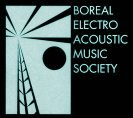|
|
Installations
POD - Wind Array Cascade Machine (2003)
Location:
The Works Site #19
Latitude 53 Centre for Contemporary Visual Culture
2nd Level, 10248 - 106 st
Hours: Tues - Fri 10 am - 6 pm
Sat Noon - 5 pm
Closed - Sun, Mon, Canada Day
|
Wind Array Cascade Machine (WACM) is a telematic
64 channel environmental mapping and network diffusion system.
Using the wind that blows across an open field or rooftop, WACM's
64 motion sensors track the amplitude and wave movement of the
wind in real time. Direction and wave movement of the wind is captured
in the network data set. The wave patterns in this piece metaphorically
represent the sound (sine) wave. The WACM data is then streamed
over the WWW anywhere in the internet world to the Heimbecker installation
in using the 64 channel WACM data set.
POD (2003) is the first installation created for
the Wind Array Cascade Machine (WACM) system. POD is a 64 channel
installation that uses 2880 light emitting diodes (LEDs) to portray
a real time 4 dimensional picture of the wind, where each of 64 "pods" functions
as an amplitude meter of the 64 wind sensors of the WACM data network.
Although this installation is silent, a large portion of the audience
(approximately 30%), have inquired about the sound source within
this light installation, indicating a synaesthetic response to
it. The electronic and software systems for POD were designed in
collaboration with Avatar, Québec, Canada. POD was most
recently exhibited at Oboro, Montréal, Canada directly after
it's European premiere at the Museum of Contemporary Art Kiasma,
Helsinki, Findland for ISEA 2004.
|
|
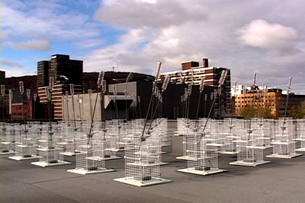 |
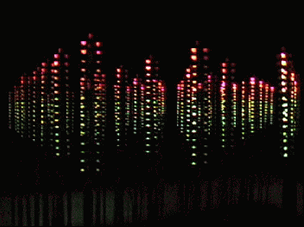 |
Triquetraflux II (2002)
Location:
The Works Site #9
Telus Plaza
North Tower
10025 - Jasper Ave
East Entrance, Street Level
Hours: Daily 11 am - 8 pm
The Triquetraflux in
its most basic form is an acoustic sound generating organism. It
consists of three interconnected "harps," cone-shaped
structures of ten strings, each touching the sides of a large colourful
balloon suspended above the floor. There are three sizes of harp,
tuned to three consecutive octaves. Each harp "listens" to
the others and reacts to the constantly shifting sets of frequencies
to create a chaotic feedback system that produces sound. This sound
is then sent back to the other harps, which then react and send
their responses back to the first harp. This loop flows continually
through all three harps. It exists in the moment and reacts to
itself in real time, according to what has just happened an instant
before. All sound heard from this system is acoustic; there are
no speakers. Only the balloons amplify the vibrational energy of
the strings. The quality of the sound is ethereal, quiet and elusive,
often moving swiftly from one harp to another. The brass strings
stretched over the cables surrounding the balloons can be seen
moving into and out of vibration. These strings can be touched,
and the effect of the loss of sound from a particular string can
usually be seen and heard throughout the ensemble of three harps.
Left undisturbed, the piece will constantly vary itself as well
as react to ambient sound and shifting air currents (sometimes
produced by patrons moving near the piece.) A computer allows for
dynamic control of the feedback pathways within each harp, changing
the probabilities. The limits can be adjusted in real time or they
can be pre-set. These controlled limits turn the Triquetraflux
into a real - time stochastic composition machine.
|
|
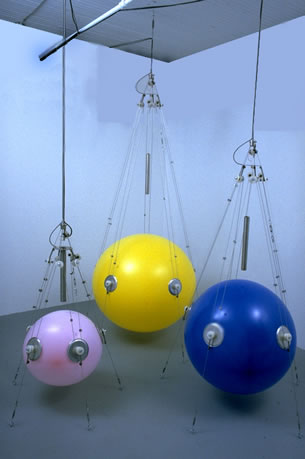 |
Surrogate for Natural Harmony (Loodusharmoonia
aseaine) (2005)
Location:
The Works Site #10
The World Trade Centre
2nd Floor, 9990 - Jasper Ave
Hours: Daily 10 am - 8 pm
The installation "Surrogate
To Natural Harmony" by Ivika Kivi and Sulo Kallas is one possible
vision of the future.
The sounds of these birds create a meditative soundscape.
Listening to them with eyes closed, it is easy to picture real
birds singing in the forest. Resting in such a room might have
a therapeutic and calming effect; at the same time, such an area
would be easy to maintain. The installation needs no other power
source than the light of the sun or an electric light. Surrogate
Nature has become a product of fashion since the 20th century.
The Sun that has given life to the complex evolutionary processes
on our home planet, in the same way, is giving life to these robotic
birds.
|
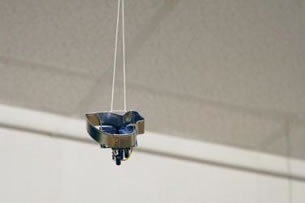 |
In the future, when
there is too much pollution for birds and other life forms, where
will we go to be in harmony with nature. In our mind, we associate
nature to the sound of birds singing. When it is gone, how easy
is it to accept this disappearance? Assuming that most people on
the earth live in the cities and will not notice the disappearance
of natural areas, this installation presents the simplicity of
finding a replacement to a source of nature with new technology.
This work presents the seductive beauty of modern life, where we
are distanced from thinking about our role within the natural world.
Through the mass media, we are led to believe that technology will
solve all our problems. Being part of the very same techno-culture,
the artists are concerned about losing their place in the natural
world.
We all might be quite surprised how quickly we
can adjust to the new conditions...
|
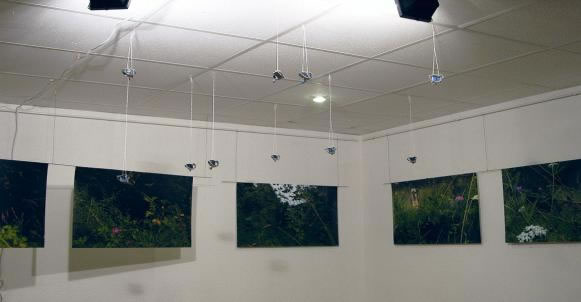 |
|


